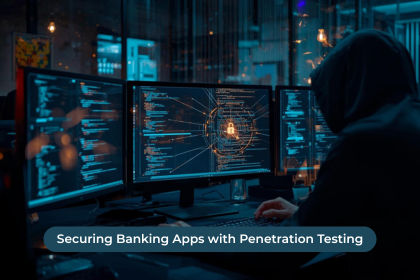Cyberattacks are the plague of our times, especially for the BFSI sector. A 2024 IBM study drives this point home: Financial institutions faced cyberattacks 300 times more frequently than companies in other sectors.
This raises an uncomfortable question: what could happen if you have not implemented cybersecurity measures for your organization yet? A typical, traditional security initiative is set to be outdone by sophisticated threat actors moving at machine speed. However, you can not be outmatched, if you opt for penetration testing services.
In the age of umpteen customer log ins and fund transfers via mobile, UPI payments and sensitive information stored in banks, your app must be secure. As one overlooked vulnerability has the power to shatter the system, mobile app penetration testing is the defence capability you need in your arsenal. It will offer deep visibility, more control plus context, enabling pentesting as a strategic shield against modern threats.
Why Banking Apps are Prime Targets
Banking means money. Mobile apps mean easy target. Therefore, cyber criminals are lured towards private, sensitive customer data, direct financial access and a broad user base in mobile banking apps. Threat actors, therefore, deploy core mechanics to exploit everything from insecure code and exposed APIs to weak authentication systems.
To further underpin why banking apps are the primary targets, here are a few examples:
- Man-in-the-Middle attacks can intercept transactions if encryption is misconfigured.
- Credential stuffing attacks take advantage of users who reuse passwords.
- API exploitation can expose transaction histories and account balances.
Without planned, regular penetration testing services, these threats remain invisible to you while they remain visible for cyber attackers to exploit.
The Role of Penetration Testing Services in Banking App Security
A new generation of penetration testing services combining automated scans and human-enabled testing have emerged. And that’s the gold standard according to pentesting experts.
Such penetration testing service providers simulate real-world attacks on your mobile application. They use automation to scan hundreds and thousands of vulnerabilities, while human overview and expertise is sought to test, find and fix exploitable flaws in the mobile app. Plus, a clear, prioritized roadmap for remediation is provided.
The difference in the banking sector is that one-off efforts for protecting code is not enough. You need to safeguard customer trust, meet compliance and potentially secure billions of dollars in transactions.
Targeted and thorough, penetration testing goes deeper, manually probing business logic, session handling and transaction processes, keeping organizations abreast of the current security posture and how it can be improved.
A Banking-Focused Penetration Testing Roadmap
A penetration testing service program kicks off with scoping and defining the rules of engagement in collaboration between pentesters and banking decision makers.
- Discovery and Reconnaissance
Security experts begin by mapping the mobile application’s architecture. A passive scanning of public facing components plus active fingerprinting of digital footprints. Various tools are used to identify entry points, integrations with payment gateways and third-party services. This includes examining API endpoints, authentication flows and backend services.
- Static Application Security Testing (SAST)
Next comes the stage where the app’s source code is thoroughly reviewed without execution. For banking apps, this step is critical for spotting hardcoded credentials, weak cryptography and insecure libraries. The bad actors cannot and should not dwell here.
- Dynamic Application Security Testing (DAST)
In this stage, the heavy lifting happens where pentesters run the app to find vulnerabilities in real-time. This uncovers issues like broken session management, insecure data storage on devices and unprotected communication channels.
- API and Backend Testing
Banking apps rely heavily on APIs for everything from account balances to fund transfers. Penetration testing here ensures proper authentication, authorization and rate-limiting to prevent abuse, making sure everything is under your control.
- Reverse Engineering and Tampering Checks
Penetration testers decompile the mobile app to detect if sensitive logic or credentials can be accessed. They also check if attackers could modify the app to bypass security checks.
- Reporting and Remediation Guidance
The final stage consists of findings compiled into an executive-friendly report with screenshots of critical functions compromised, clear risk ratings, guidance for developers and more.
Why IT Leaders Should Champion Penetration Testing Services
From a leadership perspective, penetration testing services should be seen a risk management investment and something that help businesses hold an advantage with three major payoffs:
- Protecting customer trust: A cybersecurity incident can cause more damage to brand reputation than years of poor service. And customer trust is a premium in banking sector.
- Regulatory compliance: Banking apps must comply with PCI DSS, GDPR, PSD2 and other regulatory standards. Penetration testing services at frequent intervals demonstrates due diligence.
- Operational resilience: Knowing weak points in the system allows organizations to patch them before they become entry points for attackers and resultant problems.
Future Trends in Mobile App Penetration Testing for Banking
With all the cybersecurity innovations and cyber-attack sophistication, the penetration testing exercise is at an inflection point. With the breakneck pace of AI adoption and security development, you can expect a few trends to shape how penetration testing services are delivered:
- Continuous Penetration Testing – Banking apps will need to undergo continuous assessments. This means secure software development cycle where vulnerabilities will be detected as soon as new code is pushed.
- AI-Enhanced Testing – Artificial intelligence cannot be stopped now. And it shouldn’t be ignored. AI will help pentesters identify complex vulnerabilities faster by simulating attacker behaviour at scale.
- Cloud-Native Security – As banking apps increasingly are attracted towards on cloud infrastructure, penetration testing scope will widen with deeper assessments of cloud configurations and identity management.
- Regulation-Driven Testing – New compliance mandates may require certified penetration testing providers for the financial sector.
How CyberNX’s CERT-In Empanelled Penetration Testing Services Can Help?
At CyberNX, our expert team uses cutting-edge tools and deep technical expertise to uncover high-risk system vulnerabilities—fast. We help organizations: identify weaknesses before attackers can, close compliance gaps, evaluate security team response times, understand real attack impact, and take targeted remediation steps.
Armed with top industry certifications (OSCP, CEH, CISSP), our testers emulate modern adversaries with persistence, stealth, and precision. We replicate real-world threat actor behaviour—from reconnaissance and exploitation to post-exploitation—leveraging the latest TTPs (tactics, techniques, and procedures). Our penetration testing reports deliver a strategic, prioritized roadmap so you fix what matters most first.
CyberNX seamlessly integrates findings into your broader security strategy, aligning outcomes with risk appetite, compliance mandates, and business objectives.
Why CERT-In Empanelment Matters
As a CERT-In empanelled provider, CyberNX is authorized by India’s top cybersecurity agency to conduct audits and penetration tests for regulated and critical sectors. This ensures national-level credibility, compliance alignment, and trust—especially vital for industries managing sensitive data or under government oversight.
Industries We Secure
Here are some of the major industries we secure:
- BFSI: Fraud simulations, insider threat testing, SWIFT security.
- Fintech: Mobile app, API, and payment gateway assessments.
- SaaS: Multi-tenant security, access control testing.
- Healthcare: HIPAA-aligned, ePHI protection testing.
Conclusion
Banks are where the money is, and therefore they will always be under the cyber attacker’s radar. Penetration testing services give you the visibility and the confidence to release banking app features quickly without compromising safety.
If you are leading a financial institution investing in penetration testing services will be a masterstroke. Because your customers trust you with their money and you have to make sure that the mobile app is as secure as your vault.
Partner with seasoned experts like CyberNX who understand the unique demands of the financial sector. With CyberNX’s domain expertise and tailored penetration testing services, you can outpace attackers, meet compliance demands and most importantly protect the customer trust.
Penetration Testing Services FAQs
How often should a banking app undergo penetration testing services?
For high-risk financial applications, experts recommend conducting penetration testing services at least twice a year or after every major code update. Continuous testing is ideal for apps with frequent feature releases or regulatory changes.
Can penetration testing disrupt normal banking app operations?
When performed by certified professionals, penetration testing is designed to be non-disruptive. Testing is usually done in staging or sandbox environments to prevent any impact on live customer transactions.
What qualifications should I look for in a penetration testing provider for banking apps?
Choose providers with certifications like OSCP, CEH, CREST, or PCI QSA, and proven experience in financial services security. Sector-specific expertise ensures the penetration testing services align with banking regulations and real-world threats.
How do penetration testing results translate into business decisions?
Findings from penetration testing services are typically mapped to business impact, helping leaders prioritize fixes that reduce the highest risks first. This ensures security investments are targeted for maximum ROI.









